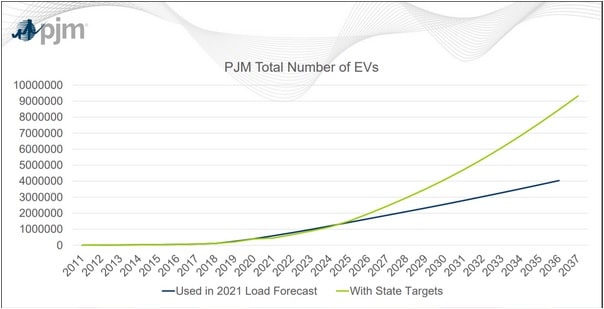Anticipated Growth in Electric Vehicles Contribute to PJM’s Long-Term Forecast

The 2022 load forecast report of PJM Interconnection LLC, which manages the electric grid across 13 states and the District of Columbia, estimates summer and winter peak loads to rise by 0.4 percent and 0.7 percent, respectively, over the next 10-year period starting this year. Net energy for load growth in the grid operator’s footprint is expected to average 0.8 percent per year over the decade, with total energy forecasted to reach 845,133 gigawatt-hours (GWh) in 2032, an increase of 63,815 GWh over 10 years.
Net energy impact of plug-in electric vehicles and peak load impact of battery storage have been newly added to the latest forecast report. Electricity use for electric vehicles is projected to reach nearly 21,000 GWh of energy by 2032, up from 2,414 GWh this year. The grid operator’s December 2021 presentation on preliminary forecasts highlights that the forecasts are driven by states with plug-in EV targets across its footprint.
The grid operator relies on the load forecasts to determine how much power it needs three years from now in its capacity auctions. The report lowers the peak load estimate for 2025 – the upcoming capacity auction delivery year – by 763 MW or 0.5 percent. The auction, initially scheduled to be held this month, has been delayed pursuant to an order from the Federal Energy Regulatory Commission. PJM’s capacity auction for the 2022-2023 delivery year, held in May, the first auction under market reforms that extended the minimum offer price rule pursuant to the 2019 order, yielded 64 percent lower prices than the prior 2018 auction and the lowest in almost a decade.
PJM also uses forecasts to plan its transmission system. By the 2027 summer peak, when the next study of Regional Transmission Expansion Plan is due, the forecast declines by about 249 MW.
Other key projections in the report:
- Summer peak load is projected to rise by 0.4 percent each year to 154,381 megawatts (MW) and winter peak load to rise by 0.7 percent to 141,516 MW.
- Annual energy use is forecast to grow by 0.8 percent a year over the next 10 years, up from 0.7 percent in the last report.
- Plug-in electric vehicles are expected to contribute 1,840 MW of summer peak load by 2032, up from roughly 300 megawatts in 2022.
- Rooftop solar impact to summer peak load is anticipated to be 3,150 MW in 2022 and by about 6,700 MW in 2032;
- Batteries are expected to lessen summer peak load by 5 MW in 2022 and by 258 MW in a decade.
The load forecast method includes input variables for end-use saturation and efficiency as well as economic drivers in PJM’s forecast models for residential, commercial, and industrial sectors. The first step towards defining peak and energy forecasts is based on insights from this method and data from historical weather. The report also examines data from electric distribution companies and modifies the forecasted growth in conjunction with behind-the-meter solar generation, batteries, and plug-in electric vehicles.
EnerKnol Pulses like this one are powered by the EnerKnol Platform—the first comprehensive database for real-time energy policy tracking. Sign up for a free trial below for access to key regulatory data and deep industry insights across the energy spectrum.
ACCESS FREE TRIAL